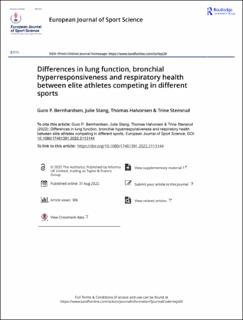Differences in lung function, bronchial hyperresponsiveness and respiratory health between elite athletes competing in different sports
Journal article, Peer reviewed
Published version

View/
Date
2022Metadata
Show full item recordCollections
- Department of Clinical Science [2291]
- Registrations from Cristin [9482]
Abstract
The aim of this study was to examine lung function, bronchial hyperresponsiveness (BHR) and exercise-induced respiratory symptoms in elite athletes performing different sports. Norwegian national-team athletes (30 swimmers, 32 cross-country skiers, 16 speed-skaters, 11 rowers/paddlers, 17 handball players and 23 soccer players) completed a validated questionnaire, measured exhaled nitric oxide (FENO), spirometry, methacholine provocation (PD20met) and skin prick test. Three cut-off levels defined BHR; i.e. PD20met ≤2 µmol, ≤4 µmol and ≤8 µmol. Mean forced vital capacity (FVC) was highest in swimmers (Mean z-score[95%CI] = 1.16 [0.80, 1.51]), and close to or higher than reference values according to the Global Lung Initiative equation, across all sports. Mean forced expiratory volume in 1 s (FEV1) was higher than reference values in swimmers (0.48 [0.13, 0.84]), and ball game athletes (0.69 [0.41, 0.97]). Mean forced expiratory flow between 25 and 75% of FVC (FEF25-75), and/or FEV1/FVC were lower than reference values in all endurance groups. BHR defined by ≤2 and ≤8 µmol methacholine was observed in respectively 50%–87% of swimmers, 25%–47% of cross-country skiers, 20%–53% of speed-skaters, 18%–36% of rowers/paddlers, and 0%–17% of the ball game athletes. Exercise-induced symptoms were common in all groups, most frequent in cross-country skiers (88%), swimmers (83%) and speed-skaters (81%).
